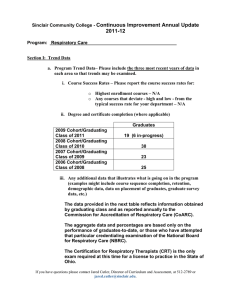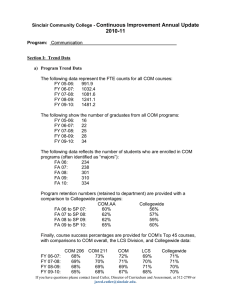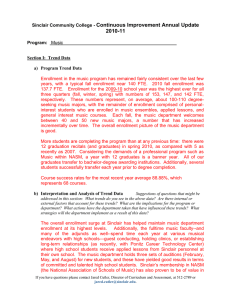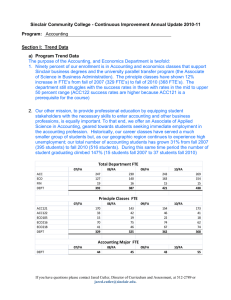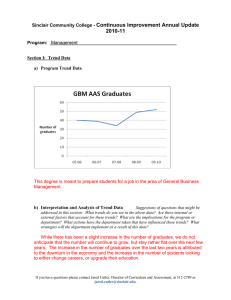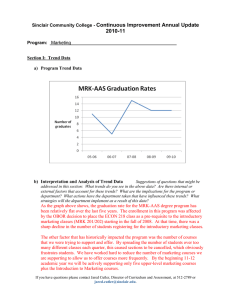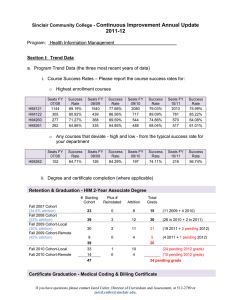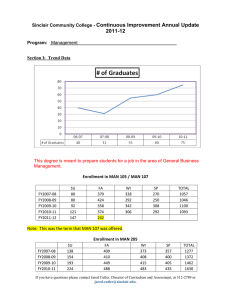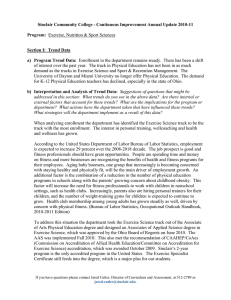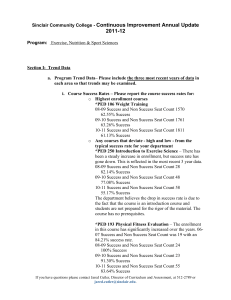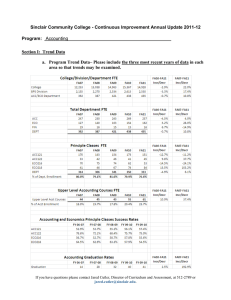Continuous Improvement Annual Update 2010-11
advertisement
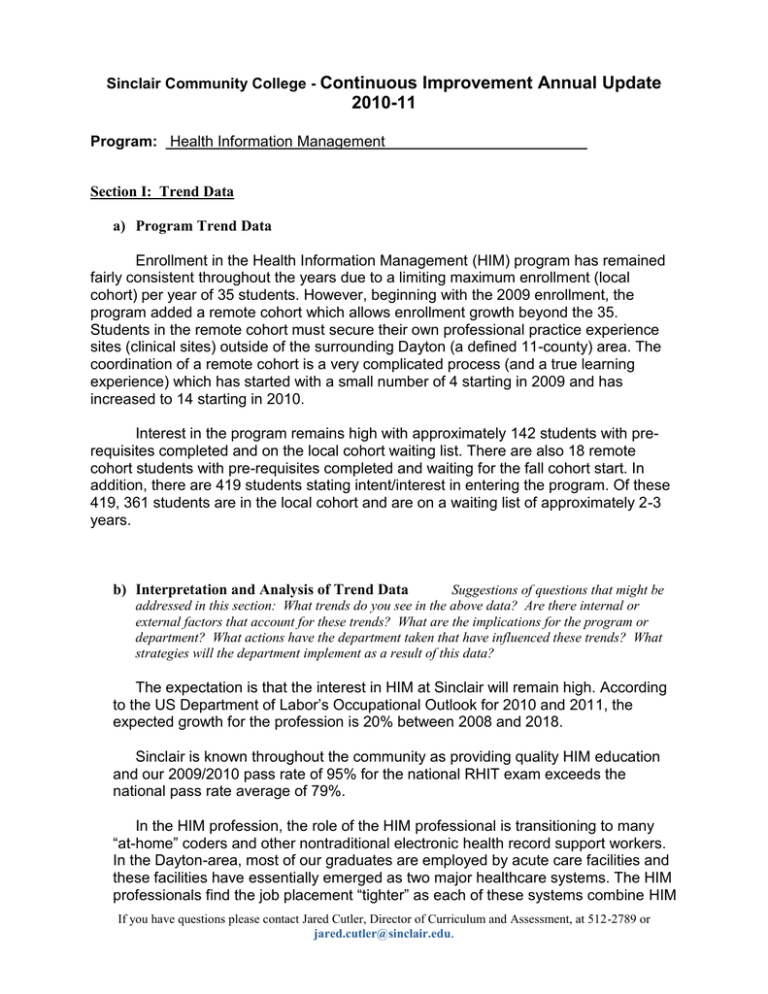
Sinclair Community College - Continuous Improvement Annual Update 2010-11 Program: Health Information Management Section I: Trend Data a) Program Trend Data Enrollment in the Health Information Management (HIM) program has remained fairly consistent throughout the years due to a limiting maximum enrollment (local cohort) per year of 35 students. However, beginning with the 2009 enrollment, the program added a remote cohort which allows enrollment growth beyond the 35. Students in the remote cohort must secure their own professional practice experience sites (clinical sites) outside of the surrounding Dayton (a defined 11-county) area. The coordination of a remote cohort is a very complicated process (and a true learning experience) which has started with a small number of 4 starting in 2009 and has increased to 14 starting in 2010. Interest in the program remains high with approximately 142 students with prerequisites completed and on the local cohort waiting list. There are also 18 remote cohort students with pre-requisites completed and waiting for the fall cohort start. In addition, there are 419 students stating intent/interest in entering the program. Of these 419, 361 students are in the local cohort and are on a waiting list of approximately 2-3 years. b) Interpretation and Analysis of Trend Data Suggestions of questions that might be addressed in this section: What trends do you see in the above data? Are there internal or external factors that account for these trends? What are the implications for the program or department? What actions have the department taken that have influenced these trends? What strategies will the department implement as a result of this data? The expectation is that the interest in HIM at Sinclair will remain high. According to the US Department of Labor’s Occupational Outlook for 2010 and 2011, the expected growth for the profession is 20% between 2008 and 2018. Sinclair is known throughout the community as providing quality HIM education and our 2009/2010 pass rate of 95% for the national RHIT exam exceeds the national pass rate average of 79%. In the HIM profession, the role of the HIM professional is transitioning to many “at-home” coders and other nontraditional electronic health record support workers. In the Dayton-area, most of our graduates are employed by acute care facilities and these facilities have essentially emerged as two major healthcare systems. The HIM professionals find the job placement “tighter” as each of these systems combine HIM If you have questions please contact Jared Cutler, Director of Curriculum and Assessment, at 512-2789 or jared.cutler@sinclair.edu. efforts within their networks. Job placement in for 2009 graduates was at 86.6% and has dropped to 81.25% for 2010 graduates. Section II: Progress Since the Most Recent Review a) What was the fiscal year of the most recent Program Review for this program? 2007 b) Briefly summarize the goals that were listed in Section IV part E of the most recent Program Review Self-Study (this section of the Self-Study asks “What are the department’s/program’s goals and rationale for expanding and improving student learning, including new courses, programs, delivery formats and locations”)? We have proposed an entirely web-based cohort of the HIM associate degree program. There are presently nine courses in the Medical Office Coding Certificate and all but BIO 107 is available online. If this obstacle is overcome, there might be significant opportunity for an increase in enrollment. The success rate in HIM121 (63% for the last 3 years) is undesirable. One of our goals for this top-45-enrollment course is to look at this course and examine our learning activities to determine if any changes could be made to improve student success. We implemented a mid-curriculum capstone course (HIM178) in the summer between the first-year and second-year course work. We will assess its success. c) Have these goals changed since your last Program Review Self-Study? If so, please describe the changes. While the other goals have been important and essentially completed, our focus over the last several years has been concentrated on creating the entirely webbased course curriculum. d) What progress has been made toward meeting any of the goals listed above in the past year? Entirely web-based cohort: Completed August, 2010 BIO 107 available online: Completed 2008 If you have questions please contact Jared Cutler, Director of Curriculum and Assessment, at 512-2789 or jared.cutler@sinclair.edu. Enrollment growth in Medical Office Coding Certificate (now known as Coding and Billing Specialist Certificate): 4-year trend data shows number of degrees issued: 06/07 = 40, 07/08 = 76, 08/09 = 79, 09/10 = 136 Success rate for HIM 121: 63% in 2006 to 79% in 2009 Success rate of mid-curriculum capstone course: Pass rates on national RHIT exam: 10/1/09-9/30/10 10/1/08-9/30/09 10/1/07-9/30/08 National Annual Pass Rate 79% 86% 78% SCC Program Annual Pass Rate 95% 95.7% 83% e) What Recommendations for Action were made by the review team to the most recent Program Review? What progress has been made towards meeting these recommendations in the past year? Recommendation for the department to continue to closely monitor the balance of graduates and job opportunities. The department is encouraged to gather and assess data where available regarding anticipated demand for the program. Progress: Graduate employment is measured annually. Community, employer and professional demands are obtained via bi-annual HIM Advisory Committee communication which is comprised of community HIM members and other members of vested interest. Recommendation to articulate the SCC program with the baccalaureate degree completion program at the University of Cincinnati. Progress: Completed 9/1/10. Recommendation to assess the feasibility of offering Sinclair’s program fully online. Progress: Completed development of fully-online courses 8/2010. Recommendation to develop a succession plan to ensure continuing strong leadership for the department. Progress: Karen Motley became chairperson in June 2008 with Barb Wallace serving as chairperson mentor for one year. Karen continues to serve as the chairperson. Applicant qualifications of succession hiring of tenure-track faculty have been developed and utilized with the ensuing hiring of new faculty (as a result the retiring of experienced faculty). Recommendation to position the department to respond to education and needs for the migration to I-10-CM PCS (new coding system). Progress: With the advent of the 10/1/13 implementation date of I-10-CM PCS, one faculty member has acquired the I-10 Certification. The development of the curriculum’s changes to include I-10 have been scheduled, a transition course to I-10 for the students has been scheduled, faculty education has begun and plans for the community If you have questions please contact Jared Cutler, Director of Curriculum and Assessment, at 512-2789 or jared.cutler@sinclair.edu. educational piece are underway with an organizational meeting which occurred in February 2011. This was comprised of HIM (coding) community members . Recommendation to investigate how students who have studied at proprietary institutions and now wish to enter Sinclair’s program might best be served. Consider alternatives such as prior learning assessment and proficiency exams as avenues for these students to demonstrate mastery of selected competencies. Progress: Prior learning assessments have been developed for students who have extensive “work in the field” and proficiency exams have been utilized for HIM121, HIM122, HIM260, HIM261. Other equivalencies for professional credentials have been developed and are utilized for demonstrating mastery of selected competencies. Recommendation to encourage all graduates of the program to take the national certification exam promptly upon graduation in order to increase the likelihood of success on the exam. Progress: Students are now offered the option of taking the national RHIT exam within their final quarter of the program. Students are continually encouraged by SCC HIM faculty to take the exam within the last part of the program’s final quarter or soon thereafter. A “testimonial” from a past grad has been instituted into the program’s final capstone course to allow students to hear the “message” from a peer. Recommendation to monitor impact of the program’s new pre-requisites on student enrollment, progression and success. Progress: Program enrollment remains high. Impressively, our attrition rate has declined (2010 graduates = 28.5% attrition, 2009 graduates = 34.7% attrition, 2008 graduates = 45.1%). Recommendation to consider alternative admission practices in order to enable students to begin the program at multiple points in the year. Such practice holds promise for filling slots created by attrition and thus increasing response time on wait lists and being more cost-effective. Progress: This recommendation has been discussed and considered, however due to the program’s “lock-step” course progression, allowing students to enter the program at multiple points during the year is not feasible. If you have questions please contact Jared Cutler, Director of Curriculum and Assessment, at 512-2789 or jared.cutler@sinclair.edu. Section III: Assessment of Outcomes The Program Outcomes for this program are listed below. At least one-third of your program outcomes must be assessed as part of this Annual Update, and across the next three years all of these program outcomes must be assessed at least once. Health Information Management Program Outcomes 1) Demonstrate the ability to design, organize and implement changes in the evolution of health information to electronic formats. 2) Apply effective skills in the areas of written and oral communication, critical thinking, and problem solving in the practice of health information management. 3) Demonstrate the ability to perform the health information associate degree entry-level competencies as identified by the American Health Information Management Association. 4) Evaluate and appropriately apply principles of confidentiality and privacy congruent with the standards and ethics of the health information profession. 5) Demonstrate personal behaviors, attitudes and values consistent with and appropriate to the entry-level health information management professional. In which courses are these program outcomes addressed? HIM 110, 111, 135, 240, 265, 178, 241, 244, 245, 246, 250, 251, 252, 218 HIM 121, 122, 110, 111, 260, 261, 165, 135, 240, 265, 178, 241, 244, 245, 250, 246, 228, 249, 251, 218, 252, 278 HIM 110, 111, 260, 261, 165, 135, 240, 265, 178, 241, 244, 245, 250, 246, 228, 249, 251, 218, 252, 278 HIM 135, 178, 250, 251, 252 HIM 110, 111, 121, 122, 260, 261, 165, 135, 240, 265, 178, 241, 244, Which of these program outcomes were assessed during the last fiscal year? Assessment Methods Used We compared our results of AHIMA’s subdomains with the national average. We implemented professional behaviors and values questions on our If you have questions please contact Jared Cutler, Director of Curriculum and Assessment, at 512-2789 or jared.cutler@sinclair.edu. 6) Demonstrate proficiency in classifications and nomenclatures sufficient to support reimbursement in multiple patient care environments. 7) Demonstrate competency and skill in the technology used by the healthcare information environment. 245, 250, 251, 252, 246, 228, 249, 218, 278 HIM 260, 261, 240, 241, 178, 251, 252, 218 HIM 110, 111, 135, 265, 178, 241, 245, 250, 251, 246, 252 Professional Practice Experience Daily Activity Log sheets. a) For the assessment methods listed in the table above, what were the results? What changes are planned as a result of the data? How will you determine whether those changes had an impact? We compared our 10/1/09 – 9/20/10 national RHIT exam results of AHIMA’s subdomains with the national average. Our results revealed 100% of our results of each subdomain to be above the national average. Although changes are constantly made to improve teaching strategies and learning outcomes, no changes are planned as a result of the data. We implemented professional behaviors and values questions on our Professional Practice Experience Daily Activity Log sheets. Each day that students are at their PPE site, the students must assess the professional behavior, work ethic, peer discussions and appearance of themselves and the workers around them. These assessments are monitored by SCC HIM faculty for 100% compliance/completion each clinical day. Students are also evaluated on these same behaviors by their PPE supervisor. All aspects of professionalism continue to be emphasized in all HIM courses and no changes are planned as a result of the data. b) What other changes have been made in past years as a result of assessment of program outcomes? What evidence is there that these changes have had an impact? The department made a conscious decision to convert from using Learning Resource Packets in coding courses to textbooks. This has been a negative learning experience for faculty in that the textbooks do not deliver the “customized” coding instruction needed to provide students with reinforced technical coding skills. Student and faculty frustration and complaints have multiplied. Evidence of this impact includes complaints about the expense of the textbooks, frustration due to the incorrect answers in the textbook, and the inflexibility to adequately “teach” the critical thinking required to arrive If you have questions please contact Jared Cutler, Director of Curriculum and Assessment, at 512-2789 or jared.cutler@sinclair.edu. at the correct code. We have revamped the past LRPs and are again using them in coding courses. c) Describe general education changes/improvements in your program/department during this past academic year (09-10). Critical reading standards were included and discussed with students in HIM110 (first HIM course in the curriculum). Grading rubrics were added to discussion forums to inform students of the critical thinking and reasoning that must be included in discussion posts. Section IV: Improvement Efforts for the Fiscal Year a) FY 09-10: What other improvement efforts did the department make in FY 09-10? How successful were these efforts? What further efforts need to be made? If your department didn’t make improvement efforts during the fiscal year, discuss the strengths and weaknesses of the department over the last year and how the department plans to address them in the coming year. Our Medicolegal course was transformed to include the theory and application of HIPAA, response to subpoenas, ARRA, and use of professional software for release of information. Our rates on student national RHIT competencies will not yet reflect this change but this change should prove increased AHIMA subdomain scores in Healthcare Privacy, Confidentiality, Legal, and Ethical Issues. The department changed from a previous-used remote student access software to Citrix which has allowed expanded and faster accessibility to professional software for students. The HIM New Student Orientation incorporated the use of Adobe Connect which made the orientation more “conversational” and informative for HIM students entering the program. Other additional improvements to the orientation process allowed flexibility in delivering the mandated orientation. Based upon student feedback, the portfolio project (scheduled/due in the last quarter of the program) was introduced to students in the first course of the program. This “up-front” alert provided students with information about documents and evidence of accomplishments that would need to be produced in their final project of the program. b) FY 10-11: What improvement efforts does the department have planned for FY 10-11? How will you know whether you have been successful? Based upon assessment of program outcomes, student feedback and community needs, HIM students need further exposure to an electronic health record (EHR). If you have questions please contact Jared Cutler, Director of Curriculum and Assessment, at 512-2789 or jared.cutler@sinclair.edu. We are investigating the use of Vista, a free, open-source electronic health record currently used by the VA hospitals. Meetings with IT have been set for April 2011 and the feasibility of using this technology in our program will be investigated. We will know whether we are successful if we are able to implement and utilize the EHR in HIM coursework. Questions regarding completion of the Annual Update? Please contact the Director of Curriculum and Assessment at 512-2789 to schedule a time to review the template and ask any questions. If you have questions please contact Jared Cutler, Director of Curriculum and Assessment, at 512-2789 or jared.cutler@sinclair.edu.
